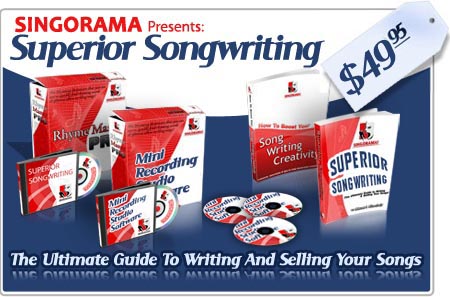4 Important Song Writing Basics You Need to Know
 So, you’ve got some ideas in mind, but where do you start? Although you could just sit down and start improvising, it is better to have a “map” of where you are musically.
So, you’ve got some ideas in mind, but where do you start? Although you could just sit down and start improvising, it is better to have a “map” of where you are musically.
In other words, you’ll want to:
– Determine which key you want to write in
– Determine which time signature (e.g. 4/4) and tempo (e.g. 100 bpm) you want
– Come up with a beginning guitar chord progression
– Start thinking about melody
Let’s take a look at each of these guideposts in more depth, and discuss their impact on the lyric-writing process, when relevant.
Key of the Song
Does it matter which key you write your song in?
Yes and no.
On the one hand, you’ll need to choose a key that suits your voice if you intend to perform the song yourself. If your vocal range is good, then you’ll have a lot of options.
If your vocal range is limited, however, you’ll need to find a way to mix things up as you write more songs. See if you can push yourself to sing a half-step higher or lower than the key you usually work in.
Another factor to consider is how the key you’re in sets the mood and “color” of the song. This is about more than Major (“happy”) versus Minor (“sad”) key stereotypes.
Have you ever wondered what the difference is between, say, the key of A Major and the key of B Major?
Technically, there’s not much of a difference at all. The notes of the scale in each key differ, but under our Western system of music, all of these pitches are relative. If you’re playing a I-IV-V progression on the piano, you’ll experience the harmonic and melodic “movement” just the same in A Major as in B Major.
However, one cannot deny that certain keys are “brighter” or “darker” on particular instruments.
A pianist, for example, has access to “higher highs” and “lower lows” than a guitarist. These effects are both subtle and subjective, but they’re there. Personally, I believe it is worth it to experiment to find a key that truly matches the intended “mood” or feel of the song.
Time Signature and Tempo
Today’s modern music tends to stick to just a few time signatures, the most common being 4/4 time (4 beats per measure and a quarter note gets 1 beat).
Your time signature, along with your tempo, will also play a role in setting the mood of the song. Keep in mind, though, that not all ‘fast’ songs are upbeat, and not all ‘slow’ songs are sad. It’s just a general guideline.
Where time and tempo become truly important is in the lyric writing phase of your songwriting.
Lyrics, just like poetry, have meter and rhythm. Your vocals can be punctuated and guided by the rhythm of the song, as well as by shifts in chord progression and/or melody per each measure.
This directly affects the length of any line of verse.
For example, think of the children’s song “Mary Had a Little Lamb,” which is in 2/4 time (2 beats per measure and a quarter note gets 1 beat):
Mary had a little lamb
little lamb, little lamb
Mary had a little lamb
Its fleece was white as snow.
Recite this out-loud while counting off the beats. Notice how the lyrics fit perfectly to the time and tempo?
Now, try adding the word “beautiful”:
Mary had a beautiful lamb
beautiful lamb, beautiful lamb…
If you ‘rush’ the syllables a bit, you can make it work, but it just doesn’t sound as good, right?
Ok, now let’s add yet another word:
Mary had a strikingly beautiful lamb
strikingly beautiful lamb, strikingly beautiful lamb….
Ouch! You can tell right away that this is going to fall apart on you. There are too many syllables in too many words per measure, forcing you to break from the 2/4 time.
Chord Progression
Your chord progression plays a significant role in defining the parameters of your melody, vocal or otherwise. A common complaint about much of modern rock music is that the respect for vocal melody has disappeared.
Bands will often write songs around specific guitar riffs, and then just drop in very basic vocal melodies that follow the root notes of each chord. If that’s good enough for you, that’s ok, but it is better to stretch yourself beyond taking this easy way out if you wish to compose truly great, catchy songs.
Before you even begin composing your vocal melody, much less your lyrics, you need to sit down and create a “tone guide” by writing out:
1. Each chord in the progression, along with all of the individual notes that make up the chord.
2. All of the notes of the scale (s) for the key you’re in.
For example, let’s say you’re writing a song in the key of C Major. This will be an easy illustration to follow because the key of C Major is natural, ie, there are no sharps or flats in the scale.
Further, let’s say your chord progression is as follows:
C-F-Eminor-G-C
For each chord, write out the notes:
C = C, E, G
F = F, A, C
Emin = E, B, G
G = G, B, D
Then, write down the entire C Major scale:
C, D, E, F, G, A, B, C
At this point, what you want to do is sing the scale out-loud over each chord. Do-Re-Mi-Fa-So-La-Ti-Do. Listen to how each note sounds over each chord.
You’re bound to hear something interesting. For instance, try singing ‘A’ and then ‘C’ over the C Major chord. Hold each note for a full measure in 4/4 time. It sounds mellow and a little bit sad, right? Kind of like a plaintive lullaby.
Melody of a Song
We’ve talked a little bit about melody already, but let’s dig a little deeper. A good melody is the key to writing a hit song if that is your goal. In this case, we are talking both about vocal melody as well as the melody within the music itself. This could be a guitar riff, a piano part or anything else.
If you take a moment to analyze your favorite ‘hit’ songs, you’ll notice that the melodies involved are usually very simple. They are relatively short and serve the purpose of grabbing and maintaining your attention and interest.
A hit song may have only one primary “hook”, or it may have multiple hooks.
A good example of the latter is Roy Orbison’s “Pretty Woman.” The opening guitar riff is one melodic hook, and it is repeated throughout the song to mark the shifts from one vocal melody to another.
What Orbison did with the song in terms of “melodic contrast” is fascinating. If you haven’t heard it in a while, I recommend you go look up “Pretty Woman” on Project Playlist right now and give it another listen.
Notice how the melody shifts when he sings:
Pretty woman stop a while
Pretty woman talk a while
Pretty woman give your smile to me
Pretty woman yeah, yeah, yeah
Pretty woman look my way
Pretty woman say you’ll stay with me
Cause I need you, I’ll treat you right
Come with me, baby, be mine tonight
It is as if he’s written a “song within a song”, and it is brilliant from a structural perspective. The melody he follows when he sings “be mine tonight” leads right back into the guitar hook and primary melody of the song.
The Ultimate Guide To Writing And Selling Your Songs
Do you want to master the art of songwriting and discover the hidden secrets on transforming your thoughts and ideas into a song with ease?
Make sure you check out Superior Songwriting today!







Leave A Comment